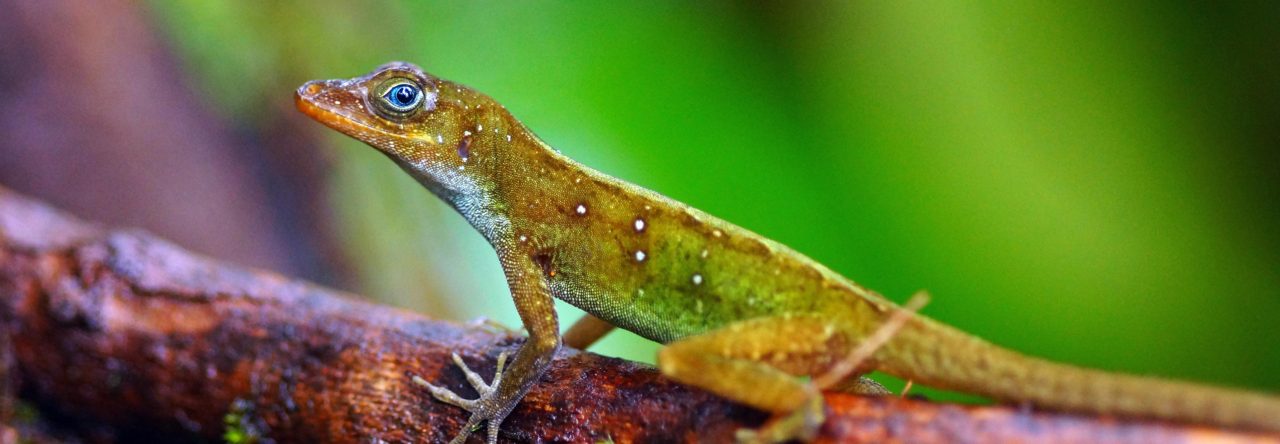Yesterday I wrote about our upcoming trip to look for the giant brown anole, A. sagrei nelsoni (and other reptiles), in the Swan Islands of Honduras. To give a little flavor of what we have in store, here are two mini-reports from trips here in the 1970’s.
First, Steve Busack’s reminiscences from a Smithsonian sponsored expedition 40 years ago:

Swan Islands iguana. Photo from http://www.tarleton.edu/Faculty/dekeith/iguana2.jpg
“Wow! It was so long ago, and my memory—aside from some pretty interesting aquatic (diving) iguanas at the dock around dusk—doesn’t recall very much. And I’m afraid that my experience with Anolis in the field is less than bountiful. I could help much more if it were Podarcis on Swan Island.
If I were given an opportunity to return, I’d have to think twice. BUT there is one issue I’ve always wanted to address if I had the opportunity. Great Swan was—at that time—”loaded” with worm snakes (Leptotyphlops if I recall correctly). One evening we took a handful (probably about 20 or so) and placed them in a chest type freezer available at the NOAA main building. After we had dinner, we returned to the dormitory and removed the specimens from the freezer. They were all frozen. We placed them on a bed in the dormitory while we worked with other specimens — allowing them to thaw before we preserved them. Several specimens actually thawed out and begain crawling off the bed. I was amazed!! A tropical snake with the ability to become frozen to the point that it is quite stiff—truly a surprising result. Because the island was accessible only by flying over from San Jose on a NOAA “supply flight,” and at the time I had no access to anything physiological, I dropped the idea of pursuing it further—thinking others I mentioned this to would have better access. To my knowledge, nobody has investigated survival of these snakes after freezing, or—more interesting—the physiological pathway they have available allowing such resistance.
One hint: if you decide to go, and wish to visit Little Swan as well, bear in mind that Little Swan is uninhabited and it’s basically a rock in the water with no fresh water. We had a tent with us, and air mattresses, but finding a place to sleep wasn’t easy. Also the island is full of the mites that infect sea birds—and people. I am not generally allergic to insect bites, but these mites sent me to an ocean bath one morning. I can’t remember if DEET was available back then, but I’d highly recommend it now. As I recall we stayed only one night on the island (radio contact and transport with the main island thanks to NOAA personnel).”
And Brad Lister, whose work I summarized yesterday, recollects:
“I do remember Swan Island and the giant sagrei very well (or is it nelsoni now?). Of all the places I’ve been, Swan seemed the most remote and enchanted.
It was the summer of 1972 and I was on the last leg of a trip to Jamaica and the Cayman Islands. NOAA had a weather station on the island and they flew me in and out. The CIA had used Swan as a staging area for the Bay of Pigs and had created a landing strip that destroyed maybe 1/4 of the forest. Apparently the island was also used for a coconut plantation at one time. At least the time I was there, the remaining forest was fairly open with a low (<10m) canopy, mainly small (10-20cm trunk diam) trees, with lots of small palms in the understory. The sagrei were fairly abundant, but not really dense. Not sure what predators might have been on the island back then, but I did see a several feral cats. I did not see any other reptiles except the big iguanas, though as I’m sure you know, Aristelliger nelsoni is listed as a resident.
Qualitatively, the anoles certainly looked like your average, every day sagrei scaled up to a larger size. Nothing striking morphologically that would distinguish them from the basic sagrei body plan. I remember being somewhat disappointed that they hadn’t evolved a more exotic look given how isolated the island is, and having just left Little Cayman and being so impressed by the really cool A. maynardi. Then again, I just measured SVLs & head size, counted lamellae, and did some other basic scale counts. In retrospect, it would certainly be interesting to get an estimate of how long the population has been on Swan and to look for the the adaptations that have been identified in solitary anoles that are utilizing a broader range of perch sites. My guess is that the large size is primarily due to competition for females, and would expect the males to spend the lion’s share of their time courting and defending their territories. Little Swan island intrigued me, but there were no small boats so I was never able to land and explore. Amazingly enough it had a species of hutia that went extinct sometime in the 1930s(?).”

The endemic and extinct hutia of Little Swan. Photo from http://www.redorbit.com/media/uploads/2004/10/42_8cf650ddccd939f96fdf01fb8572efa0.jpg
- Evolution in Real Time on Lizard Island - March 23, 2025
- Spider Snags Adult Anolis osa - March 22, 2025
- An Homage to the Green Anoles of New Orleans - March 21, 2025



Blair Hedges
I have observed the same thing with other species of Leptotyphlopid snakes, concerning survival after solid freezing. It is amazing and is worth studying, if it hasn’t been.